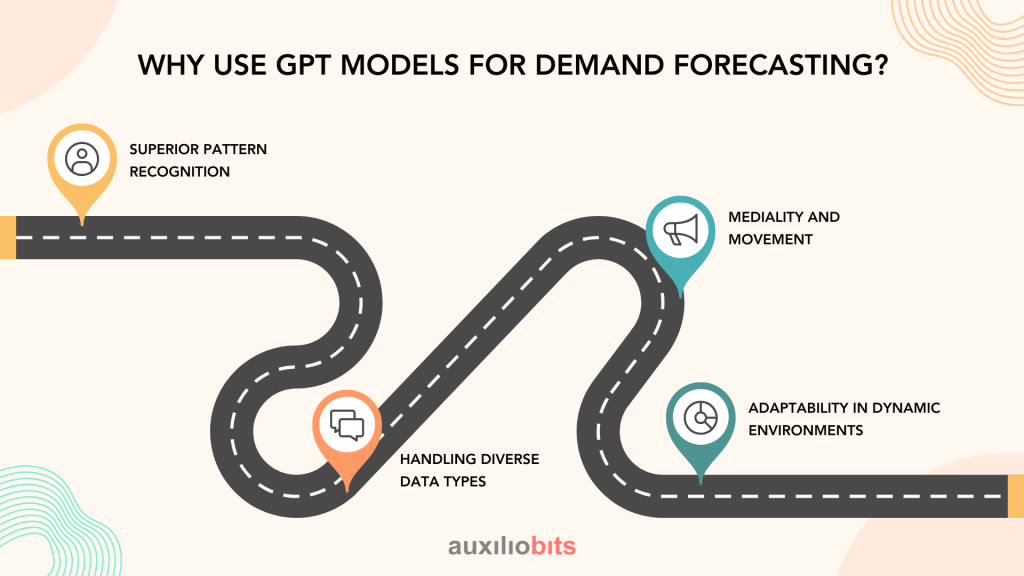
Key Takeaways
- GPT models improve precision by extracting intricate, nonlinear demand patterns in demand data.
- They combine multiple data sources, such as text and numeric inputs, for more complete forecasts.
- Pre-training followed by fine-tuning adapts them and lowers costs.
- Firms see improved inventory management and lower forecast errors.
- Limitations exist (e.g., compute cost, interpretability), but advantages usually prevail.
Demand forecasting is an essential part of conducting business and helps businesses optimize their inventory, rationalize their supply chain, and make better decisions. Statistical modeling and time-series analysis have been central to this endeavor for a couple of years. The game has changed completely with the introduction of sophisticated machine learning models, specifically Generative Pre-trained Transformer (GPT) models. GPT models, which were initially designed for natural language processing (NLP), are increasingly being employed to process numerical and time-series data to create smarter, faster, and better demand forecasts. This blog discusses how GPT models revolutionize demand forecasting, how they surpass traditional models, and their practical implementation.
Also read: Forecasting Variance Analysis with GPT-4o and LangGraph: A New Era of Conversational Forecasting
What Are GPT Models?
GPT models, developed by OpenAI and other AI research agencies, are a special type of deep learning model based on the transformer architecture. They were originally built to work on tasks such as generating text, translating language, and analyzing sentiment. Since GPTs work very well in processing and generating sequential data, they become useful in applications like demand forecasting, where the system has to pick up complex patterns in data, learn from enormous amounts of data, and generalize to other tasks.
Whereas a traditional assumption-based model, such as linearity for a regression model, imposes an explicit functional form on the underlying data, the GPT model uses its deep neural network architecture to extract complex patterns from data. As such, it can account for nonlinear relations, seasonality, and external drivers (such as economic signals, weather, and shopper behavior) affecting demand.
Why Use GPT Models for Demand Forecasting?
Here are some of the top reasons why using GPT models for demand forecasting is suitable.

1. Superior Pattern Recognition
GPT models are adept at identifying long-term dependencies and complex patterns in sequential data. In demand forecasting, this translates to better capturing seasonality, trends, and anomalies in sales or consumption data. For instance, a retailer can use GPT models to predict holiday season demand by analyzing years of sales data alongside external factors like promotional campaigns or macroeconomic trends.
2. Handling Diverse Data Types
Demand forecasting requires integrating several sources of data, including historical sales data, market trends, and even unstructured data such as customer reviews or sentiment from social media. Since GPT models can operate on both structured (numerical) and unstructured (text) data, diversifying their input sources becomes feasible in one forecasting model. This holistic approach increases the accuracy when compared with traditional forecasting methods that usually accept just numerical data.
3. Mediality and Movement
Modern GPT models are very scalable, capable of processing large data sets when deployed in powerful hardware such as a GPU or TPU. This is especially valuable for a broad portfolio of products or companies with global operations, where scale predictions are required. In addition, Fine Adjustment GPT models can produce predictions faster than traditional methods that require extensive pre-processing engineering and facilities
4. Adaptability in dynamic environments
Sudden changes in the markets are naturally dynamic through events such as supply chain interruptions or changes in customer preferences. GPT models can be adjusted or reorganized with new data to adapt to these changes, ensuring the related forecast. Their constant learning ability makes them ideal for unstable demand industries such as fashion or technology.
How do GPT Models work in Demand Forecasting?
It is essential to follow some steps to make sure that GPT models are operating in the best possible way. The steps are:
Step 1: Data Preparation
To use the GPT model for demanding demand, historical data must be structured as a sequence, the way the text is tokenized in NLP functions. For example, daily sales data for a product can be represented as a temporary chain, corresponding to the “token” in the sequence, with each data point. Additional resources, such as promotional programs, holidays or economic indicators can be coded as metadata to enrich entrance.
Step 2: Model Architecture
GPT The model has several layers of tumors attached to the transformer architecture that processes parallel input data. The self-efficacy mechanism allows the model to highlight the importance of different time stages in the sequence, allowing it to focus on the relevant pattern (for example, an increase in demand every December). For the forecast of demand, the model is trained for future values based on historical sequences, usually a sliding window approach, to generate several stages of predictions.
Step 3: Fine Training and Adjustment
Training a GPT model for demand forecasting involves feeding historical temporal data and adapting your parameters to reduce foreigners. Pre-trained GPT models, which are originally trained in spacious data sets for NLP functions, can be accommodated with specific domain data (eg retailers or manufacturing outputs) to improve performance. Fine adjustment reduces training time and resource requirements compared to training a model with scratching.
Step 4: Forecast and Evaluation
Once trained, the GPT model produces predictions that take a sequence of historical data and predict future values. These predictions can be evaluated using metrics such as average absolute error (MAE), average root error (RMSE) or average percentage
GPT Models in Action
Here’s how GPT models are transforming demand forecasting across retail, manufacturing, and e-commerce through intelligent, data-driven predictions.
Retail Industry
A global retailer used a GPT -based model to predict thousands of products in various fields. By incorporating historical sales, campaigner calendars, and social media emotions, the model has reached a 15% decrease in predictions of errors compared to traditional ARIMA models. The retailer adapted the inventory levels, reducing the shares by 10% and additional inventory by 20%.
Manufacturing Sector
An industrial equipment manufacturer led a GPT model to predict spare parts. The model integrated data with external factors such as equipment maintenance programs and economic indicators from the time chain. The result was a 12% improvement in the forecast of accuracy, allowing a better production scheme and cost savings.
Electronic commerce platform
A giant of e-commerce has applied GPT models to predict seasonal products, such as holiday decorations. By analyzing historical sales, research trends, and customer analysis, the model made accurate predictions of demand, allowing the platform to dynamically adjust prices and inventory.
Advantages Over Traditional Methods
1. Reduced Resources Engineering:
Conventional Methods such as Arima or Exponential Suading require great engineering resources to consider seasonality, trends, and external influences. This need is reduced by the ability of GPT models to identify patterns directly from gross data.
2. Non-linear modeling:
Unlike linear regression or other statistical models, GPT models are able to capture nonlinear relationships, which makes them especially suitable for complex data sets.
3. Contextual Consciousness:
The self-affection mechanism allows GPT models to consider the context of the entire data set, which improves their ability to represent long-term dependencies.
4. Flexibility:
GPT models can be applied to a variety of forecast tasks, from short-term daily forecasts to long-term strategy planning, without requiring large adjustments.
Challenges and Limitations
While GPT models offer significant advantages, they are not without challenges:
1. Computational Resources:
Training and fine-tuning GPT models require substantial computational power, which may be a barrier for smaller organizations.
2. Data Quality:
GPT models rely on high-quality, clean data. Inaccurate or incomplete datasets can lead to poor forecasts.
3. Interpretability:
Unlike traditional models, GPT models are often considered “black boxes,” making it difficult to interpret their predictions. This can be a concern in industries requiring explainable AI.
4. Cost:
The distribution of scale GPT models, especially in cloud environments, can be expensive due to the need for specialized hardware.
Best practices to implement GPT models that are in demand forecasts
1. Start small:
Start with a pilot project focused on a single product or area to test model performance before scale.
2. Take advantage of the pre-trained models:
Use pre-trained GPT models and adjust them with specific domain data to reduce time and training costs.
3. Include external data:
Improve predictions, including external factors such as climate, economic indicators, or social media trends.
4. Monitor and Train:
Inspection of the model operation to maintain accuracy in dynamic markets and training with new data.
5. Join traditional methods:
Use GPT models, along with traditional prediction methods, to create a hybrid approach that balances interpretation and accuracy.
Conclusion
GPT models are redefining demand forecasting in the sense that predictions and forecasts are generated with greater intelligence, speed, and accuracy. Since the demand-side behavior changes and data can be diverse in nature, these models stand to be a game-changer in sectors like retail, manufacturing, and e-commerce. The modeling aspect involves challenges in terms of computational costs and interpretability; operationally, however, the inherent help of GPT far outweighs its demerits if conventionally chosen as a forecasting tool. Using up-to-date advancements as a guide, the GPT approach would enable businesses to put themselves strategically one step ahead in an already competitive market.








